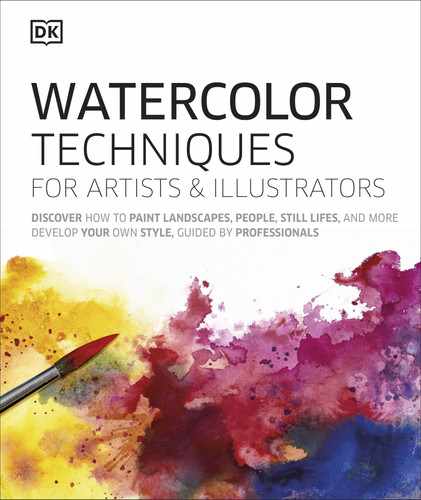
84 Beginner | TECHNIQUES
Using a sponge
CREATING TEXTURES IN PAINT
Sponging is an easy-to-control technique
that adds texture and vibrancy to your
painting. The natural dimples in a sponge
are ideally suited to creating loose effects
in watercolor, either by making marks or
lifting out color. Use sponging for many
subjects from foliage, dappled light, sea
spray, clouds, and smoke, to fur or fabric.
You will need
Neutral tint
Naples yellow
Indanthrene
blue
Green gold
Indigo
Caput mortuum
violet
Manganese
blue
Phthalo green
(blue shade)
Permanent
rose
Pure yellow
1
Light rst layers
Add the foreground grasses by dragging the sponge in short
strokes, building layers of color. Stipple color for the background
owers and seed heads, building oranges, pinks, and copper browns.
Campre scene
PUTTING IT INTO PRACTICE
Working from light to dark, the textured background
of owers and grasses was created by stippling and
dragging layers of color. A trail of smoke was added
by sponging out color when the painting was dry.
No. 000 and no. 6 soft-hair
mop brushes
Natural sponges
14 x 20 in (35 x 51 cm)
cold press 140 lb (300 gsm)
watercolor paper
Tear pieces off a larger
sponge for ease of use
when stippling
Dragging
Working dark over light, drag
the sponge in short strokes,
taking care not to overwork an
area and muddy the washes.
This method will cover large
areas quickly and is suited to
grasses, trees, and branches.
Stippling
Build texture or add natural
highlights by lightly dabbing the
sponge. Test the amount of paint
and water; too much water will
cause the texture to be lost.
Making textured marks
For best results use a natural sponge. Prepare it by
submerging in clean water and squeezing out the excess
with a paper towel. Dip into your prepared wash and
test before applying. Lightly dab or drag the sponge to
add textured marks, or lift out for softened edges.
Alter wetness
The wash doesn’t always have to
be dry. Alter the wetness of your
paint to achieve different effects,
using wet-in-wet where you want
the colors to blend.
US_084-085_Using_a_sponge.indd 84 02/04/2020 3:34pm

85 Using a sponge
2
Begin painting gure
Use different-sized brushes to paint the
more detailed gure and the re in the
foreground, using wet-in-wet and wet-on-dry
techniques to build up the layers.
4
Build texture
Drag and stipple with the sponge to build
up the darker tones and shadows in the
foliage and grass, creating more layers of
texture and interest. Add any nal details.
3
Lift off dry color
Leave the painting to dry completely, then
use a clean, damp sponge to gently rub the
path of the smoke trail to diffuse and lift the
color away. Be careful not to rub a hole!
US_084-085_Using_a_sponge.indd 85 02/04/2020 3:34pm
..................Content has been hidden....................
You can't read the all page of ebook, please click here login for view all page.
